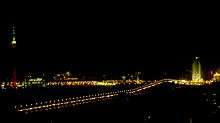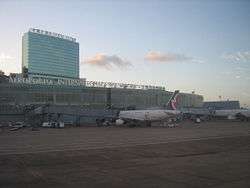Taipa
| Nossa Senhora do Carmo (Taipa) 嘉模堂區(氹仔) Our Lady of Carmel | |
|---|---|
| Freguesia | |
|
Macau International Airport | |
 Freguesia de Nossa Senhora do Carmo in Macau | |
| Coordinates: 22°9′35″N 113°33′34″E / 22.15972°N 113.55944°ECoordinates: 22°9′35″N 113°33′34″E / 22.15972°N 113.55944°E | |
| Country | Macau |
| Region | Municipality of das Ilhas |
| Area | |
| • Total | 7.6 km2 (2.9 sq mi) |
| Population (2013) | |
| • Total | 92,200 |
| • Density | 12,000/km2 (31,000/sq mi) |
| Time zone | Macau Standard (UTC+8) |
| Area code(s) | 0 |
| Taipa Island | |||||||||||||||||||||
| Chinese name | |||||||||||||||||||||
|---|---|---|---|---|---|---|---|---|---|---|---|---|---|---|---|---|---|---|---|---|---|
| Traditional Chinese | 氹仔島 | ||||||||||||||||||||
| Simplified Chinese | 氹仔岛 | ||||||||||||||||||||
| Cantonese Yale | Dáhmdzǎi Dǎu | ||||||||||||||||||||
| |||||||||||||||||||||
| Portuguese name | |||||||||||||||||||||
| Portuguese | Ilha da Taipa | ||||||||||||||||||||
| Freguesia de Nossa Senhora do Carmo | |||||||||||||||||||
| Chinese name | |||||||||||||||||||
|---|---|---|---|---|---|---|---|---|---|---|---|---|---|---|---|---|---|---|---|
| Traditional Chinese | 嘉模堂區 | ||||||||||||||||||
| Simplified Chinese | 嘉模堂区 | ||||||||||||||||||
| |||||||||||||||||||
| Portuguese name | |||||||||||||||||||
| Portuguese | Freguesia de Nossa Senhora do Carmo | ||||||||||||||||||
Taipa is an island in the Chinese special administrative region of Macau. Its name in Portuguese is "Freguesia de Nossa Senhora do Carmo".
Geography
Taipa is 2.5 kilometres (1.6 miles) from Macau Peninsula and east of the Lesser Hengqin Island of Zhuhai, Guangdong Province. Macau International Airport, University of Macau, Macau Jockey Club and Macau Stadium are situated in Taipa.
- Area: 6.33 square kilometres (2.44 sq mi) (1.5 by 3.5 kilometres (0.93 by 2.17 miles))
- Population: 70,000
Most Chinese settlement of Taipa occurred during the Southern Song Dynasty, while the Portuguese occupied the island in 1851. Prior to land reclamation, Taipa consisted of two islands: Greater Taipa and Lesser Taipa.
The 159.1-metre (522.0-foot) Big Taipa Hill (大氹山) is to the east, and Small Taipa Hill (小氹山) to the west. Central Taipa is a plain as a result of siltation and land reclamation. Initially Taipa was connected to Coloane Island only by the Estrada do Istmo (路氹連貫公路); but the area called Cotai, built on reclaimed land from 2004 and which is home to mega-resorts, casinos, and convention and exhibition centers, has now connected the two islands into one piece of land. Taipa is connected to peninsular Macau by Governador Nobre de Carvalho Bridge, Friendship Bridge and the Sai Van Bridge.
Taipa is predominantly a growing residential area with many new apartment complexes, mostly up-scale, under construction as of 2006. As a new town of Macau, Taipa has better city planning than Macau Peninsula; however, many people choose to live in Macau Peninsula since most of the famous schools are located there.
The names of Taipa
In Cantonese, Taipa has been known by many names over time, including 龍環 (Lung Waan, meaning "Dragon Ring"), 雞頸 (Gai Geng, "Chicken's neck"), 潭仔 (Tam Tsai, "Pool"), and 龍頭環 (Lung Tau Waan, "Dragon's-Head Ring").
The Portuguese and English name "Taipa" comes from the Chinese pronunciation of 氹仔 in Min Nan /tiap-á/ (similar to "tiamp-a") then became "Taipa". The putonghua pinyin for 氹仔 is dàngzǎi, and this is how the island is referred to in Mandarin. Both the character 氹 and the alternative form 凼 mean cesspit, but are obsolete in modern Chinese, and only used in relation to Taipa and the Macau-Taipa Bridge (澳氹大桥 àodàng dàqiáo). The character 氹, or 凼, is often missing from mobile phone and computer input systems.
Another version according to legend, comes from an exchange between early Portuguese settlers on Taipa and local Chinese settlers. The Portuguese asked the Chinese the name (nome in Portuguese) of the place. The Chinese settlers were local grocery shopkeepers and spoke no Portuguese, but took the Portuguese nome for the Chinese 糯米, "sticky rice", which is pronounced similar to nome in Cantonese. Thinking the Portuguese settlers were asking if they sold sticky rice, the Chinese responded with "大把," pronounced "daai ba" in Cantonese, meaning "a lot." The Portuguese, hearing the response, took this to be the name of the place. There is, however, no historical evidence to support this story. "Taipa" is also what the Portuguese call the clay-mud, rammed into moulds, used to build mud houses in Portugal in times gone by, in recent times referred to as Rammed Earth.
It is also worth noting that, as the great majority of the population in Taipa and Macau is Chinese, however there is a growing community of expatriates living in Taipa who work at the Casinos on the Cotai Strip. Most people refer to this island by its Cantonese name, "Tamzai", and most taxi drivers and bus drivers will not understand if asked how to go to "Taipa."
Education
Tertiary Educational Institutions
International schools
Tourism

- Altira Macau
- Cunha Street
- Macau Olympic Aquatic Centre
- Macau Stadium
- Museum of Taipa and Coloane History
- Taipa Houses–Museum
- Religious
- Pou Tai Un Temple (菩提園 or 菩提襌院): named after bodhi tree
- Kun Yam Temple (觀音岩)
- Tin Hau Temple (天后宮)
- Sam Po Temple (三婆廟): dedicated to the elder sister of Tin Hau
- Pak Tai Temple (北帝廟): dedicated to the Taoist God of the North
- Four-faced Buddha (四面佛): purchased from Thailand in 1985
- Church of Our Lady of Carmel (嘉模聖母教堂): Catholic church
- Other
- Macau Jockey Club
- Taipa Fort (砲台)
- Macau International Airport
See also
- Taipa Temporary Ferry Terminal — served by Cotai Jet — operates hydrofoil services to Sheung Wan, Hong Kong SAR
- List of islands and peninsulas of Macau
External links
| Wikimedia Commons has media related to Taipa. |
| Wikivoyage has a travel guide for Taipa. |
 |
Freguesia de São Lázaro | Freguesia da Sé | Pearl River / |
 |
| |
|
South China Sea | ||
| ||||
| | ||||
| Cotai Landfill Zone | South China Sea |

